The Origin Story of All Comic Book Mutants
How a 1953 article in Mechanix Illustrated spawned a new, atomic-powered breed of superhero
The two big superhero films of the summer of 2025 featured Krypto the Superdog and The Fantastic Four. These characters are comic book touchstones. The Kryptonian canine, introduced in 1955, epitomizes the cheerful goofiness of Eisenhower era Superman. The Fantastic Four debuted six years later in 1961, introducing Marvel’s new twist on the superhero formula.
What if I told you that one man is directly responsible for the creation of all of these iconic comic book characters? Otto Binder is the man who dreamed up Krypto the Superpooch. And a couple of years before that, he wrote an incredibly weird but influential magazine article—complete with comic book-style illustrations—that I’m prepared to argue is the inspiration for all future superheroes who got their powers from radiation.
Irradiated Crusaders
Many iconic comic book characters, from Spider-Man to Daredevil to the Fantastic Four, have radiation-fueled origin stories. No matter that in the real world a strong dose of radiation can cause cancer and bone necrosis, destroy chromosomes, and ruin reproductive organs. Why have so many comics linked radiation with superpowers instead of super-impotence?
I believe that we can trace all of it back to the December 1953 issue of Mechanix Illustrated. The magazine typically promised DIY projects and How-To guides for garage tinkerers, but it occasionally dipped into science and futurism. This particular issue featured the unforgettable article “How Nuclear Radiation Can Change Our Race.”
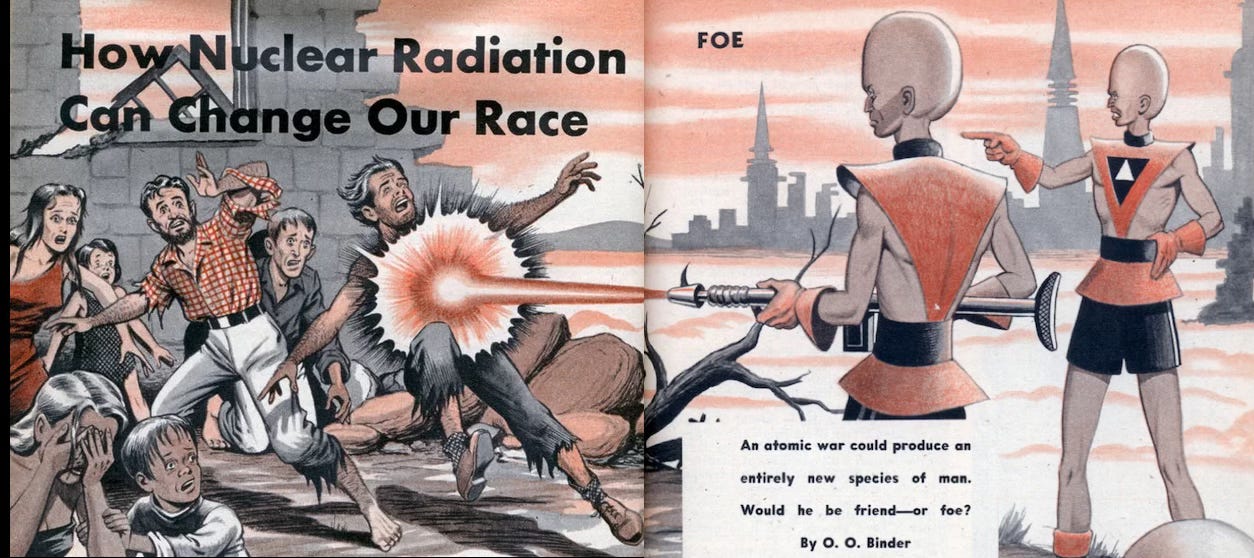
The piece begins, “Now hear this, Earth! I am Mutant Man, Homo Superior! I have been created by radiation forces out of the loins of you, the human race, after your great and terrible Atom War. Yes, I am a step above and beyond you and I am now your master for better or for worse. You created me in your blind, savage, senseless war of atomic radiation. You have only yourselves to blame if I turn out to be your—Frankenstein Monster!”
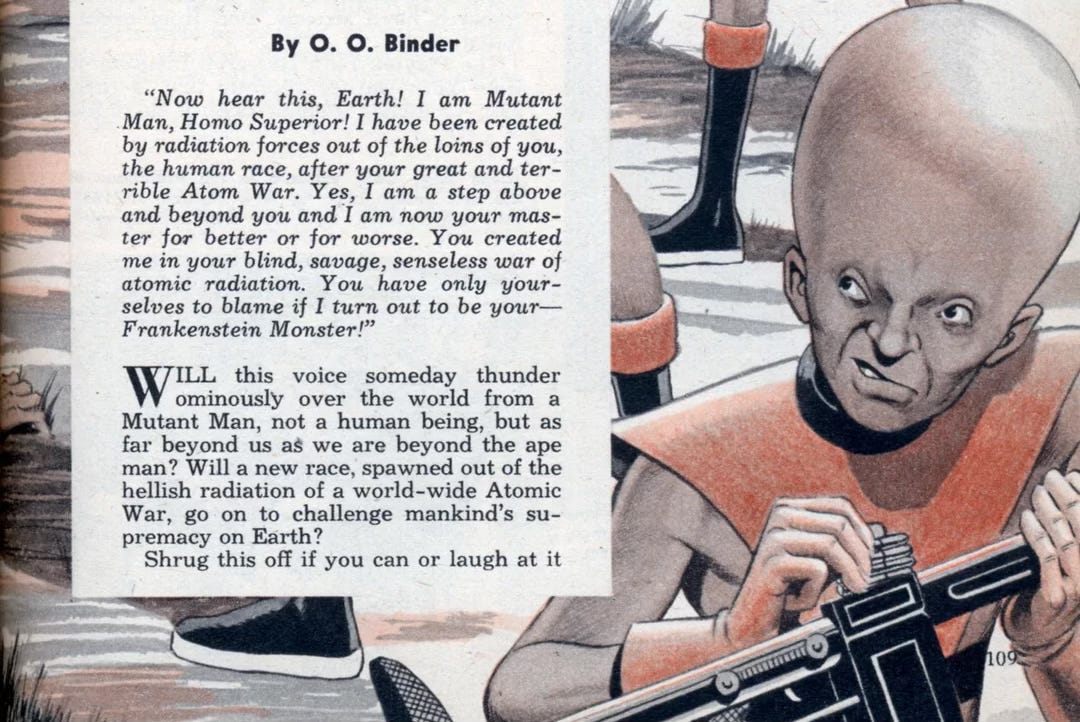
After that bold warning, there’s a feeble attempt by the author “O. O. Binder” to cite real science, like x-ray research, Hiroshima victims, and “Darwin and his theory of evolution, which burst like an atomic bomb into human thought in 1859.” But the thrust of the piece is that the atomic age is maybe probably gonna turn humans into superhumans—or horrible monsters.
This sensationalist piece is ostensibly a science-tinged thought experiment, but it has the breathlessly florid tone of a superhero comic. This isn’t surprising because O. O. Binder is actually Otto Binder, a comic book writer with 4400+ issues to his name, much of it for DC Comics. He’s the co-creator of Supergirl, he helped establish the character of Bizarro, and he dreamed up Super-foe Brainiac as well as Superman’s pet dog, Krypto.
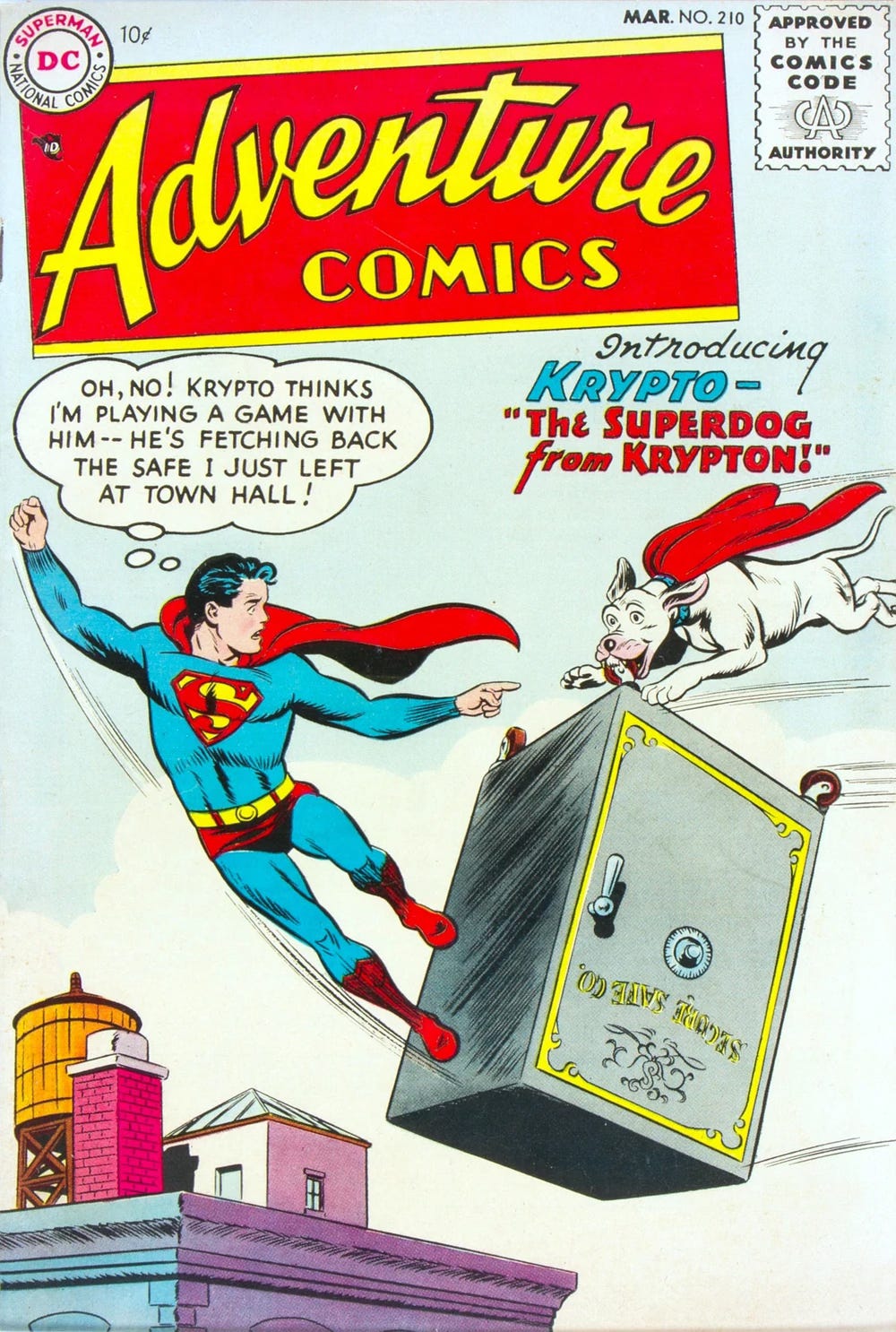
The illustrator of the Mechanix Illustrated article was Kurt Schaffenberger. At the time that he drew these eggheaded radioactive super-geniuses, he was a journeyman comic artist working for Marvel, EC Comics, Gilberton, and American Comics Group. Binder would later lure him to DC, where he would work on Superman and Captain Marvel comics. He’s particularly known for his depictions of Lois Lane.
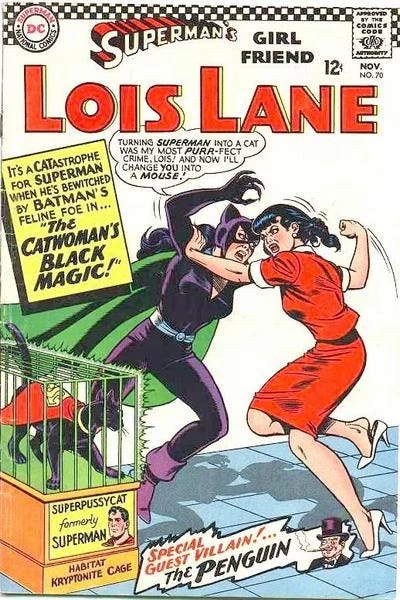
The Mechanix Illustrated article by Binder and Schaffenberger presents multiple scenarios in which humans are transformed by radiation into a strange new race of mutants. Every single scenario would go on to become a comic book trope. The core conceit is that radiation will send evolution into overdrive, producing creatures “as far beyond us as we are beyond the ape-man.”
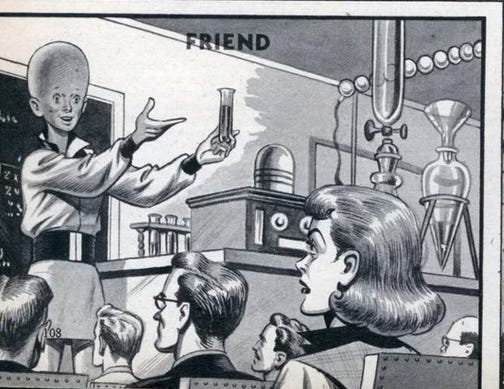
Before cosmic rays created the Fantastic Four, Binder described how it could happen
“Shrug this off if you can or laugh at it as fanciful Sunday supplement pseudo-science,” writes Binder. “But first, examine a few cold hard facts that stare us straight in the face today, showing that atomic radiation has changed us physically … What does this two plus two add up to? A frightening four. We are living in what might be called the new Age of Rays.”
The idea of radiation creating enhanced versions of human beings would later fuel the rise of Marvel comics, beginning with the November 1961 issue of Fantastic Four #1. Reed Richards takes his girlfriend and two buddies for a trip to space, where they are bombarded with weird cosmic rays that give them special abilities. “The way Jack Kirby draws the Fantastic Four going through the Cosmic Ray Belt, and suddenly something is very clearly happening to them, is such an indelible image,” says Douglas Wolk, comic book scholar and author of All the Marvels.
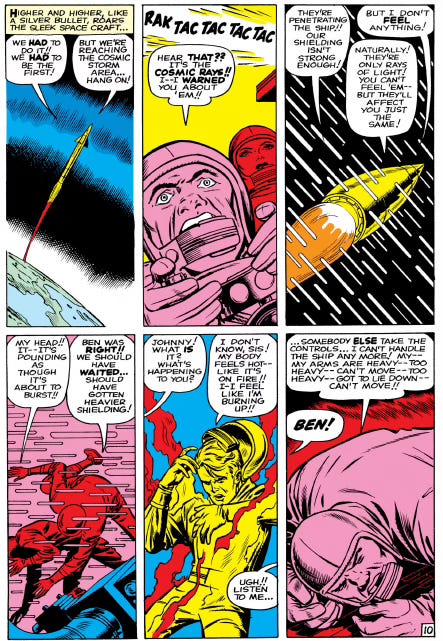
The Fantastic Four return to Earth, and their powers immediately manifest. They also immediately begin to interact in ways that the simplistic superhero teams of the time had never done. In the excerpt below, you see their bodies transform, and you also see them bicker and fight. The rock-man Thing expresses resentment and even a touch of sexual jealousy. This was spicy stuff for a medium that most people associated with the boyish Shazam (whose fanciful backstory is that he was granted the powers of six mythological figures—Solomon, Hercules, Atlas, Zeus, Achilles, and Mercury.)
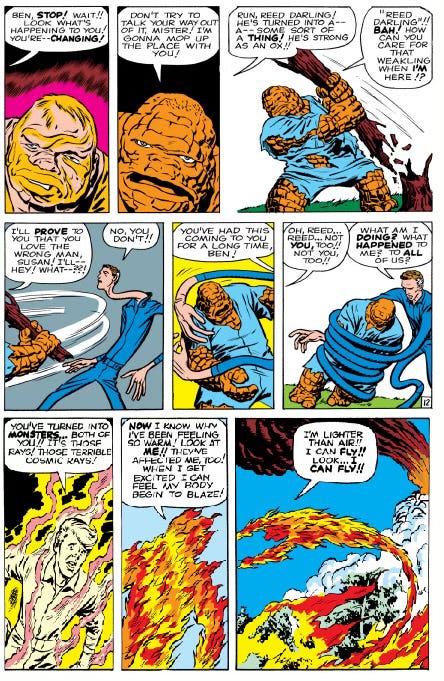
The fact that the group’s powers were supposedly derived from the actual Van Allen belt that encircles Earth added to the distinctiveness of this comic. It was slightly more sophisticated than Superman and his menagerie of Krypto the Superdog and Streaky the Supercat and Comet the Superhorse and Beppo the Supermonkey. Binder, dreamed up several of those goofy superpets, but his 1953 Mechanix Illustrated article also laid the groundwork for this new kind of comic book icon. “The Fantastic Four were specifically science fiction characters, as opposed to superhero characters,” notes Wolk.
Before gamma rays created the Incredible Hulk, Binder imagined radiation unleashing “savage new sub-men”
The piece also predicted a very different sort of superbeing when he posited that radiation could create “savage sub-men … of inferior mind.”
In prehistoric times, man was little more than a huge, slow-thinking, cruel beast. Radiations from an atomic war might easily bring such monsters back to hunt us down, to destroy our race.
By “our race,” he means homo sapiens, but the “monster” and “destroy our race” talk in this article is still extremely disquieting. (Especially since it appeared just 8 years after the genocide of WWII.) Binder goes on to write:
If enough reproductive genes are affected, say thousands of them, and if they are altered into defective new mutant-genes of the dominant type, the mutant children born would be monsters of some kind. Perhaps throwback forms of inferior mind .which would then unleash a horde of savage new “sub-men" upon civilization. They, in turn, might be more dangerous in our midst than the previous Homo Inferior, for Mutant Man might then war on us and kill us off, scorning us as a useless breed that no longer has any right to rule Earth.
Hear that, puny human? This description conjures thoughts of the Incredible Hulk, who would be introduced in 1962. His origin story: While researching Gamma Rays, scientist Bruce Banner is accidentally trapped in an atomic blast that impregnates his cells with radiation. “Banner standing in front of the trench while the bomb goes off—that is an image that sears itself on your memory,” says Wolk
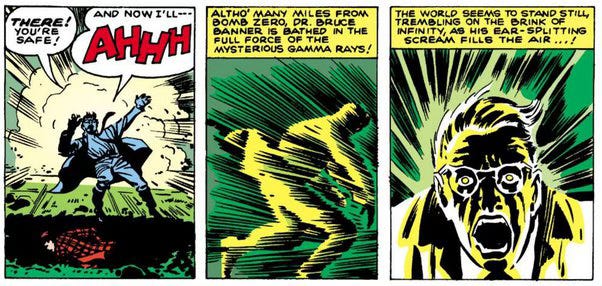
The radiation transforms Bruce Banner into a “savage sub-man of inferior mind.”
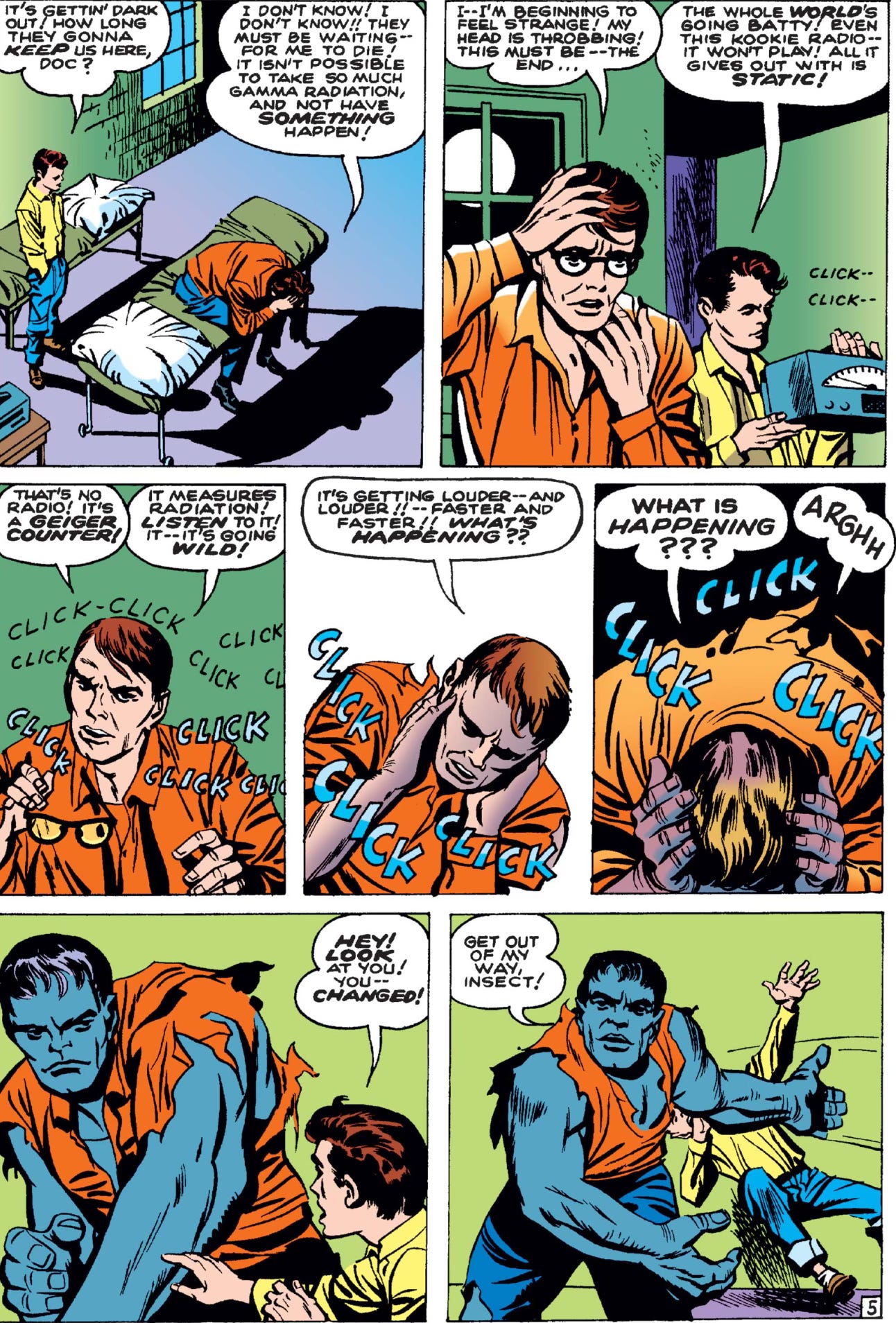
Binder’s article depicts a hulking monster. And as you can imagine, it’s bizarre nightmare fuel.
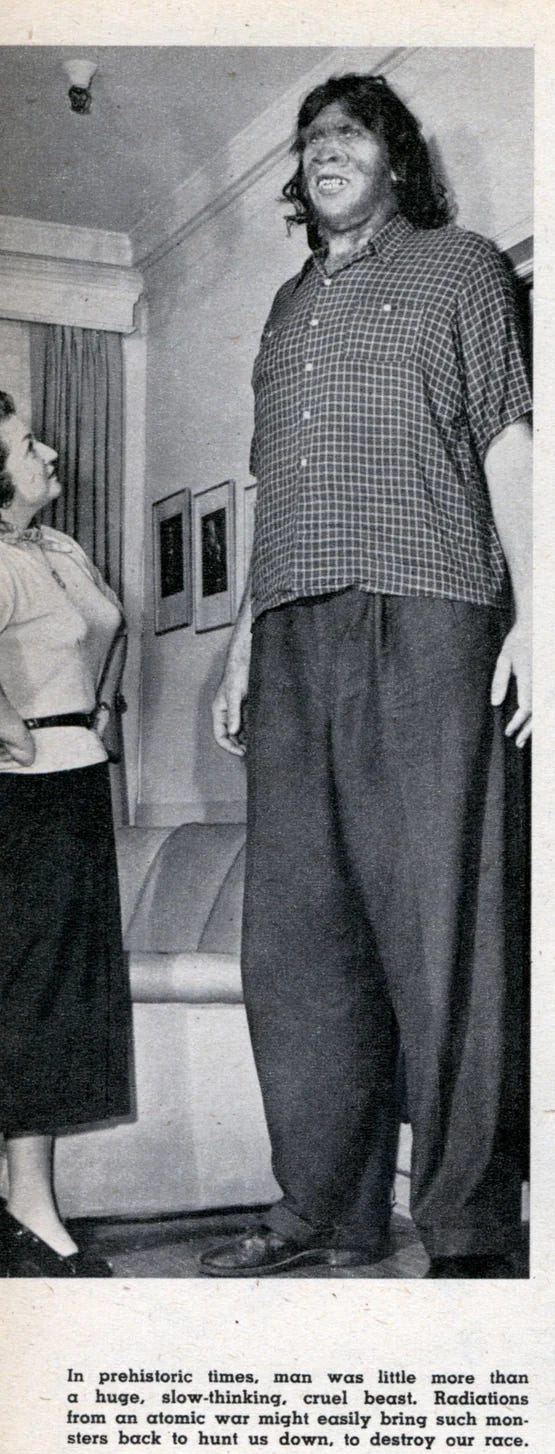
Long before Marvel’s X-Men encountered McCarthyite anti-mutant persecution, Binder imagined “a tragic, stupid witch-hunt destroying creatures better and finer than we are”
Binder imagines radiation unleashing a new species who lord over humankind. Remember, he started his article imagining how this new species might announce, “Now hear this, Earth! I am Mutant Man, Homo Superior! … Yes, I am a step above and beyond you and I am now your master!” That arrogant line seems like it could come from the mouth of Magneto, a character who would be introduced in The X-Men #1 (September 1963), which appeared almost a decade after the Mechanix Illustrated article.
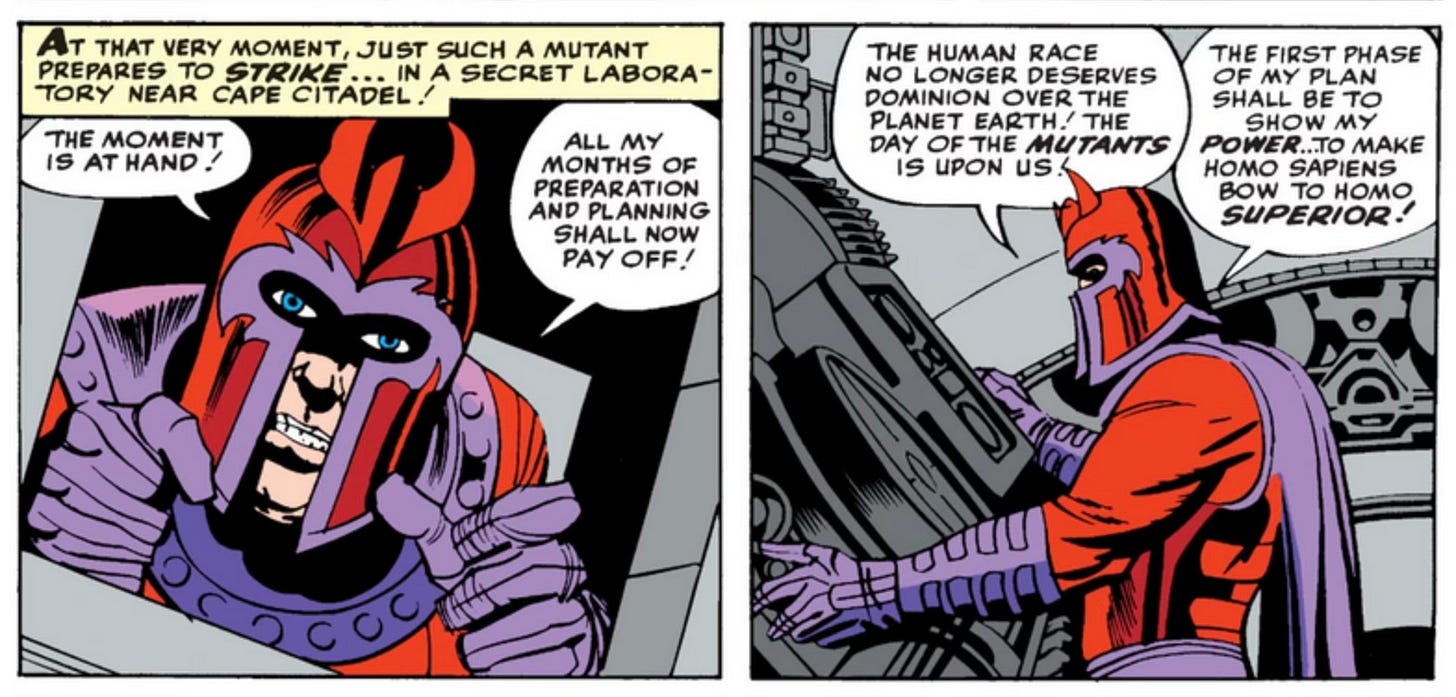
Marvel writer/editor Stan Lee and writer/artist Jack Kirby portrayed a Homo Superior who wanted to rule mankind. They also envisioned noble Homo Superiors who were threatened by fearful and violent homo sapiens. But Binder got there first as well. He wrote:
Picture the final poignant result of this deadly struggle for supremacy, between Old Man and New Man, as somewhere on Earth a panting, frightened figure is cornered in the ruins of a city by Mutant Man and there he dies—the last man.
…but the reverse might also come true, that we humans outnumber the Mutants. They might be comparatively rare, say 1,000,000 against Earth’s 2,000,000,000 humans. In which case the tables would be turned and we would hunt down and kill the last Mutant. And this might be a pity, especially if the Mutants are our superiors. Then it would be a tragic, stupid witch-hunt, destroying creatures better and finer than we are.
The X-Men issue #14 would explore exactly this sort of “tragic, stupid witch-hunt.” Its architect in that November 1965 comic was Bolivar Trask, who touched off a national campaign to demonize and persecute the “muties.”
Comic nerds debate whether it’s Stan Lee or Jack Kirby who deserves more credit for their role in establishing a new paradigm of the Space Age irradiated superhero. I posit that Binder’s odd thought experiment in Mechanix Illustrated was a key inspiration.
Do we have any evidence that the creators of Marvel’s irradiated superheroes were ever even aware of Binder’s bizarre article? I think we do…
It must be said that Wolk pours cold water on my Grand Unified Binder Theory of Marvel Comics. In fact, he thinks it’s a gross oversimplification to suggest that irradiated origin stories are a cornerstone of Marvel. He notes that the era of atomic-powered superheroes was limited to a narrow window from 1961 to 1963, and was most likely inspired by the headlines of the day and not by an article in an obscure hobbyist magazine.
“There was a moratorium on nuclear testing that ended in summer of 1961, which meant that there were mushroom clouds on the front page of the paper frequently until the partial nuclear test ban treaty went into effect in late 1963,” says Wolk. “And then you had the Cuban Missile Crisis in late 1962, and a lot of nuclear brinksmanship. That was a moment when everybody goes, ‘oh, crap this could be really, really bad.’ The Fantastic Four and the Hulk and the X-Men debuted in that moment of testing and of fear, when everyone was preoccupied by the possibility of fallout and radiation.”
That probably was the main reason these indelible characters had radiation baked into their origin stories. But in researching this piece, I stumbled on something shocking. Some overlap between the Binder article and Marvel comics that seems to line up too neatly to be a mere coincidence.
That same issue #14 of the X-Men that introduces Bolivar Trask and his “anti-mutie” crusade also depicts how the Mutant Menace is portrayed in media propaganda …including illustrations of Trask’s dire predictions labeled “ARTIST’S INTERPRETATIONS OF FATE OF MANKIND IF MUTANTS ARE NOT DRIVEN OUT.” And the illustrations look eerily familiar.
“A witch hunt for mutants!” says X-Men leader Professor Charles Xavier as he reads the xenophobic article and its lurid visuals. “The feature writers must have LOVED this, considering the way they played it up!”
The article text reads:
Artist’s interpretation of fate of mankind if mutants are not driven out–as predicted by Dr. Bolivar Trask. Dr. Trask warns that the superior abilities and supernatural powers of the hidden mutants will enable them to enslave the human race, replacing our civilization with their own! According to the anthropologist's startling prediction, it is even possible that the superior mutants will consider normal men as little more than savages, suitable only for forced labor and gladiatorial sport!
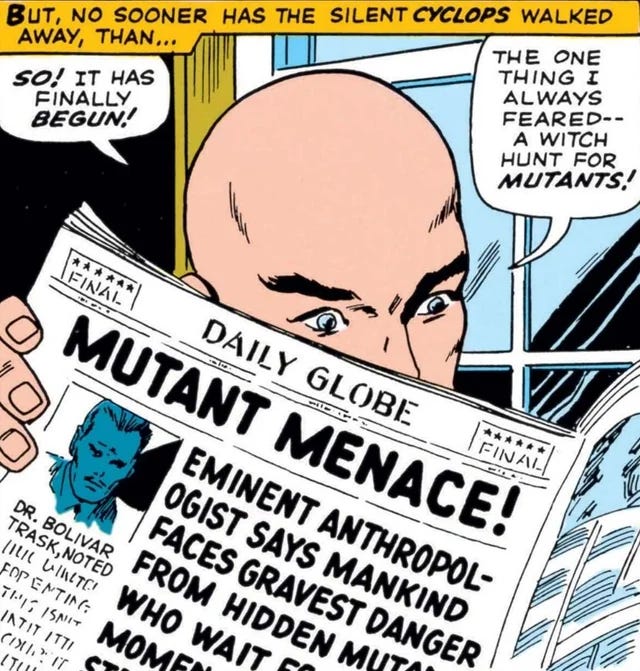
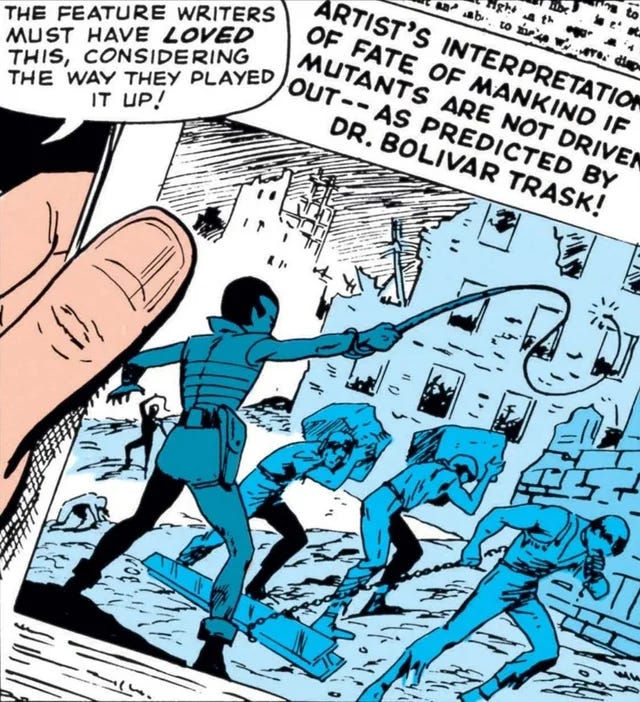
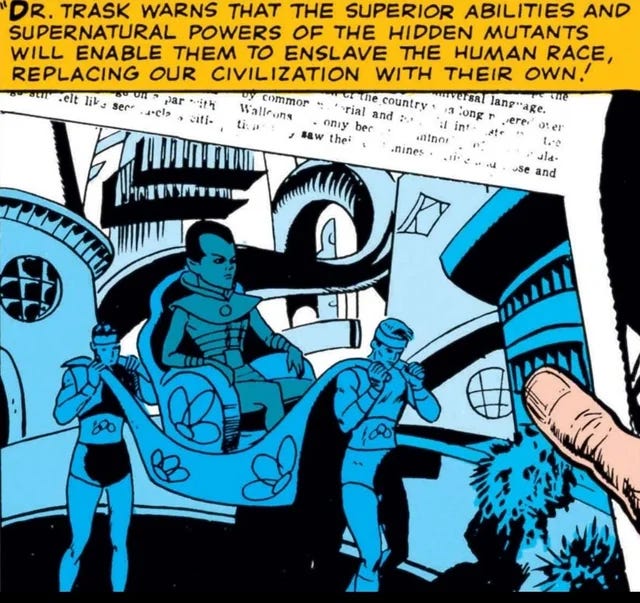
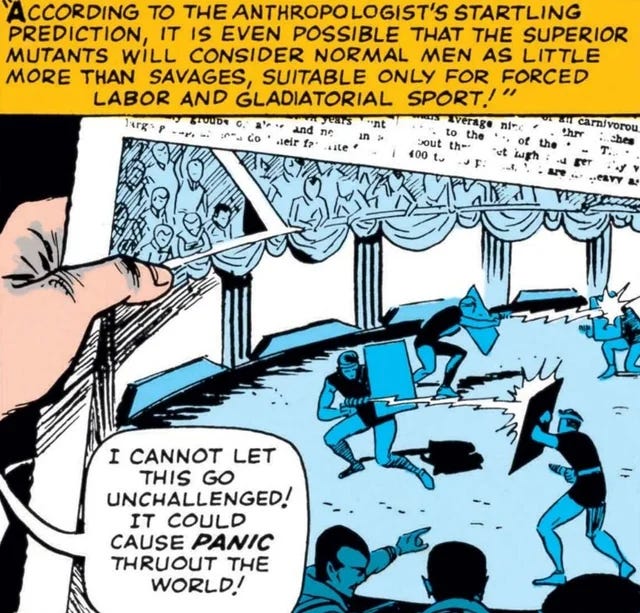
I mean, you see it too, right!? This comic book pauses to show us an article warning about the mutant menace that’s accompanied by artist renditions of humans dressed in tattered rags … at the mercy of mutants … in the ruins of a city?
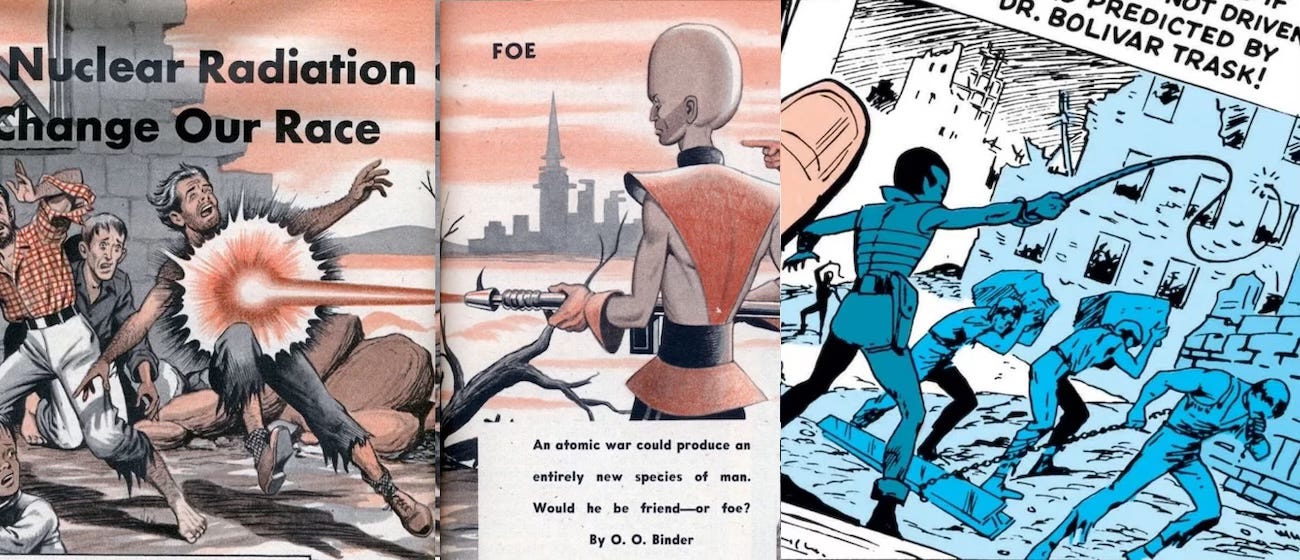
Mutants who, by the way, have giant swollen eggheads, and are wearing futuristic garb that exposes their arms and legs, complete with pointy bibs over their shoulders?
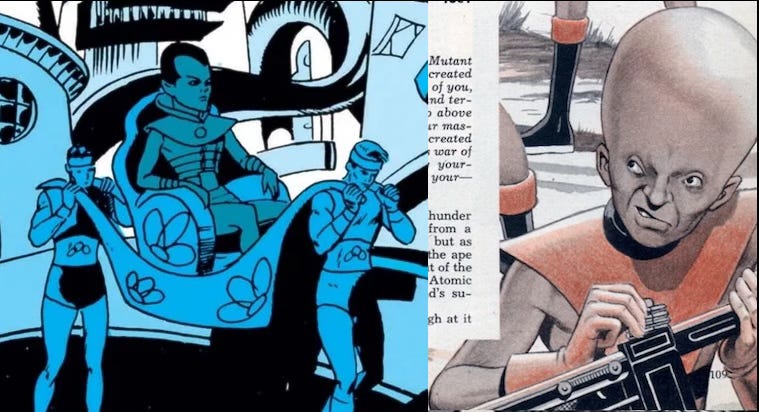
I’m calling it—STAN LEE AND/OR JACK KIRBY DEFINITELY SAW THIS MECHANIX ILLUSTRATED ARTICLE AND WERE INSPIRED BY IT.
I feel like I’ve just scratched the surface of the historical importance (and utter lunacy) of this cultural artifact. You could write a whole grad thesis about this article. I am going to share the whole damn thing below for anyone who wants to dive deeper, and you can find the entire December 1953 issue of Mechanix Illustrated on archive.org if you want to see it in its proper context. (The advertisements alone make it worth skimming...)
Elsewhere:
Douglas Wolk’s Eisner Award winning All of the Marvels: A Journey to the Ends of the Biggest Story Ever Told examines all 27,000+ issues of the comic as “the longest continuous, self-contained work of fiction ever created.” He finds several fascinating throughlines and proposes multiple ways into the franchise that are thrilling to neophytes and insightful to people who think they are familiar with this canon. His book Reading Comics: How Graphic Novels Work and What They Mean is also great. His Patreon is here.
Fantastic Four One By One by Ross Lawhead has an interesting in-depth look at Fantastic Four #1 here. Fantastic Four Daily from Rick Middleton does a similar drill down here.
Peter Sanderson does a deep dive on the backstory of Krypto the Superdog here. (He was unruly and ill-behaved in his original Binder incarnation, just like he was in the James Gunn movie.) Nick Ulanowski has more Krypto backstory here.
Forgotten Frames by Mehul Joshi has a deep dive on Binder’s role in creating an obcure character called The Black Owl here.



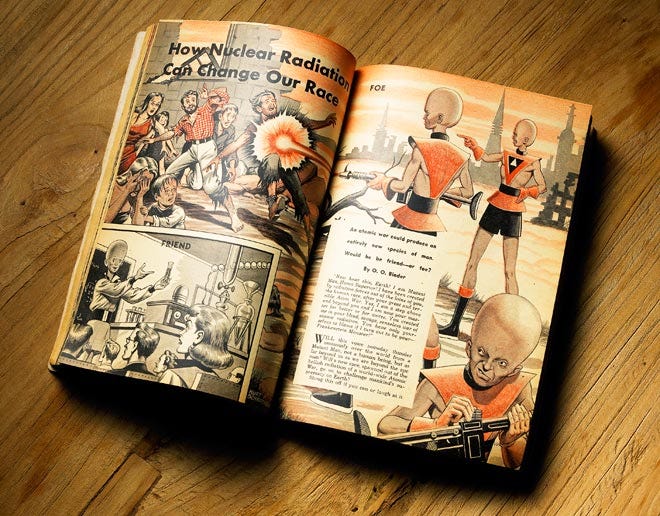
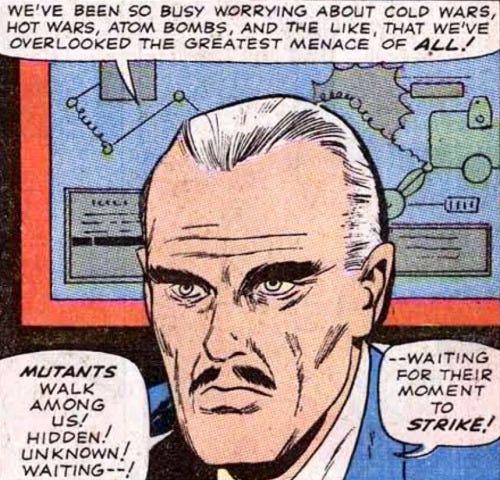
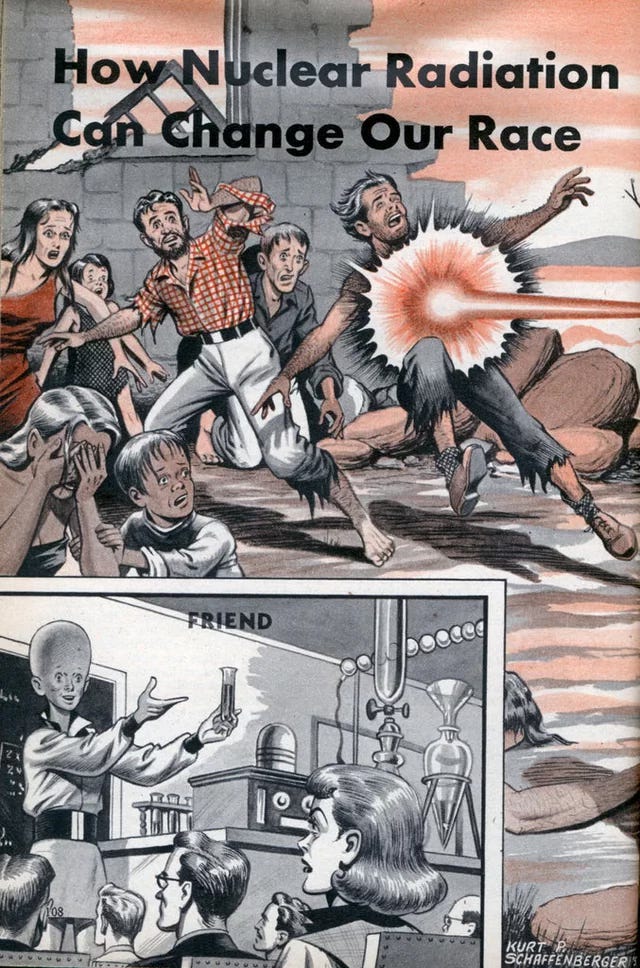
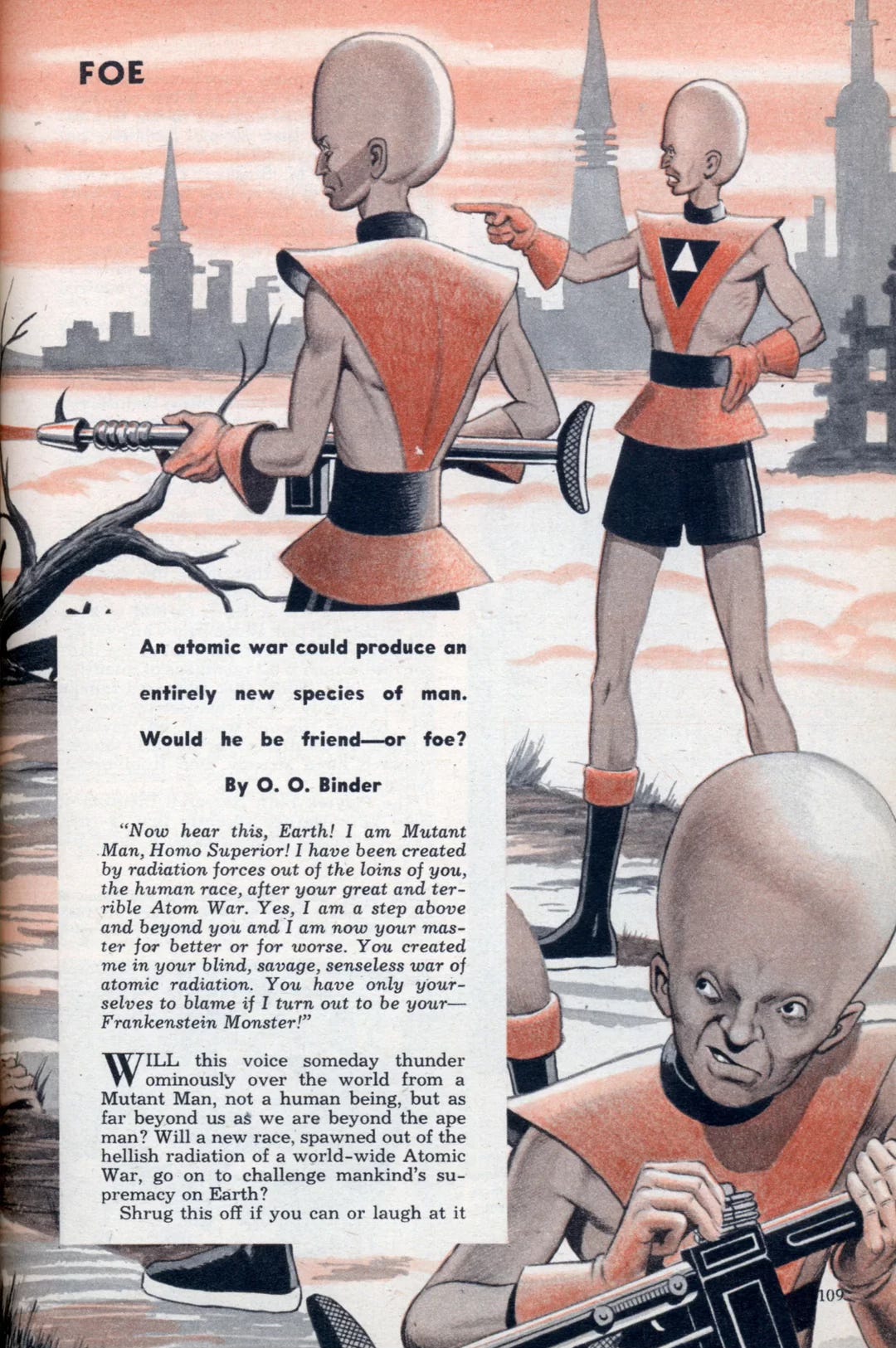
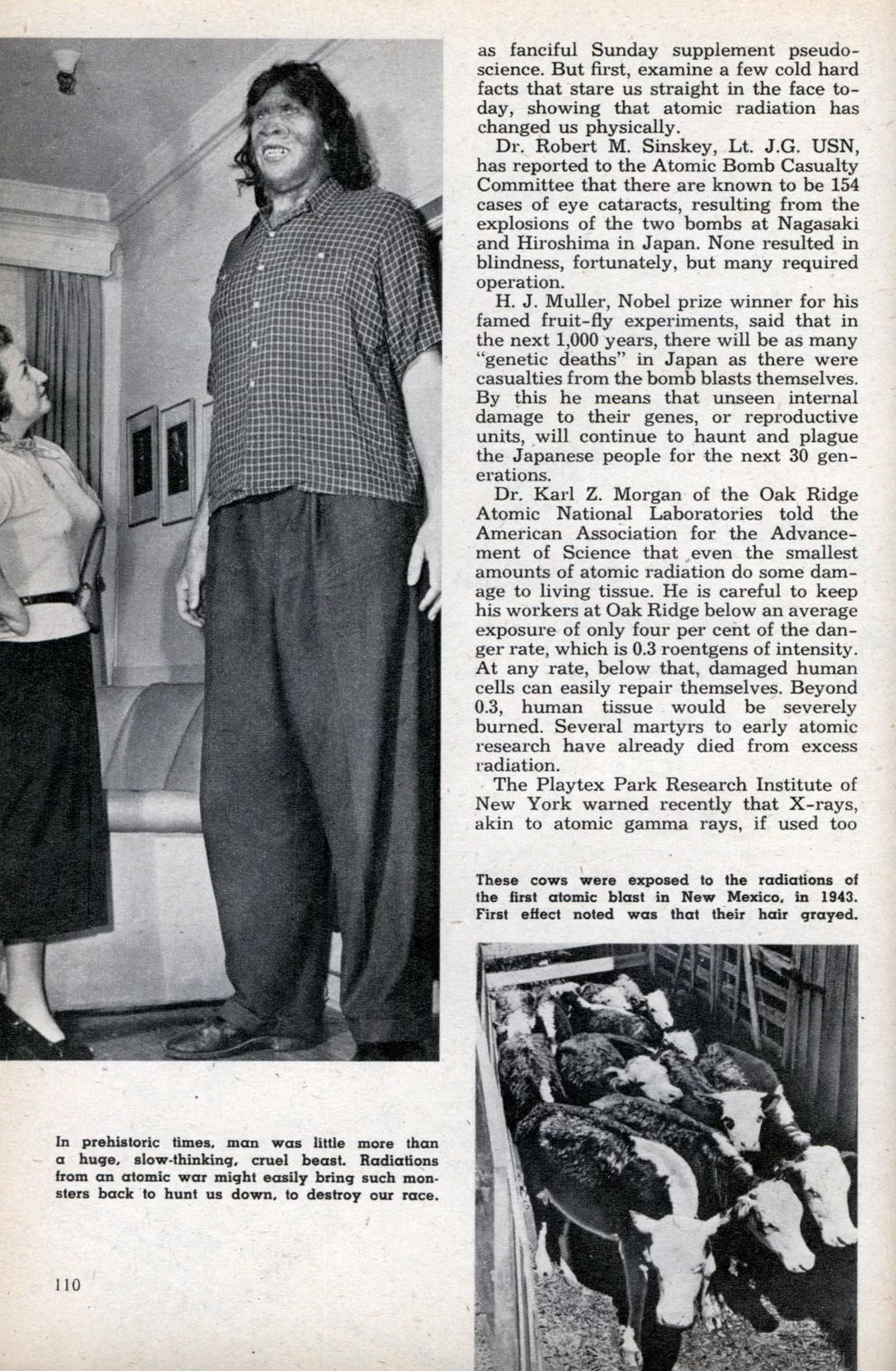
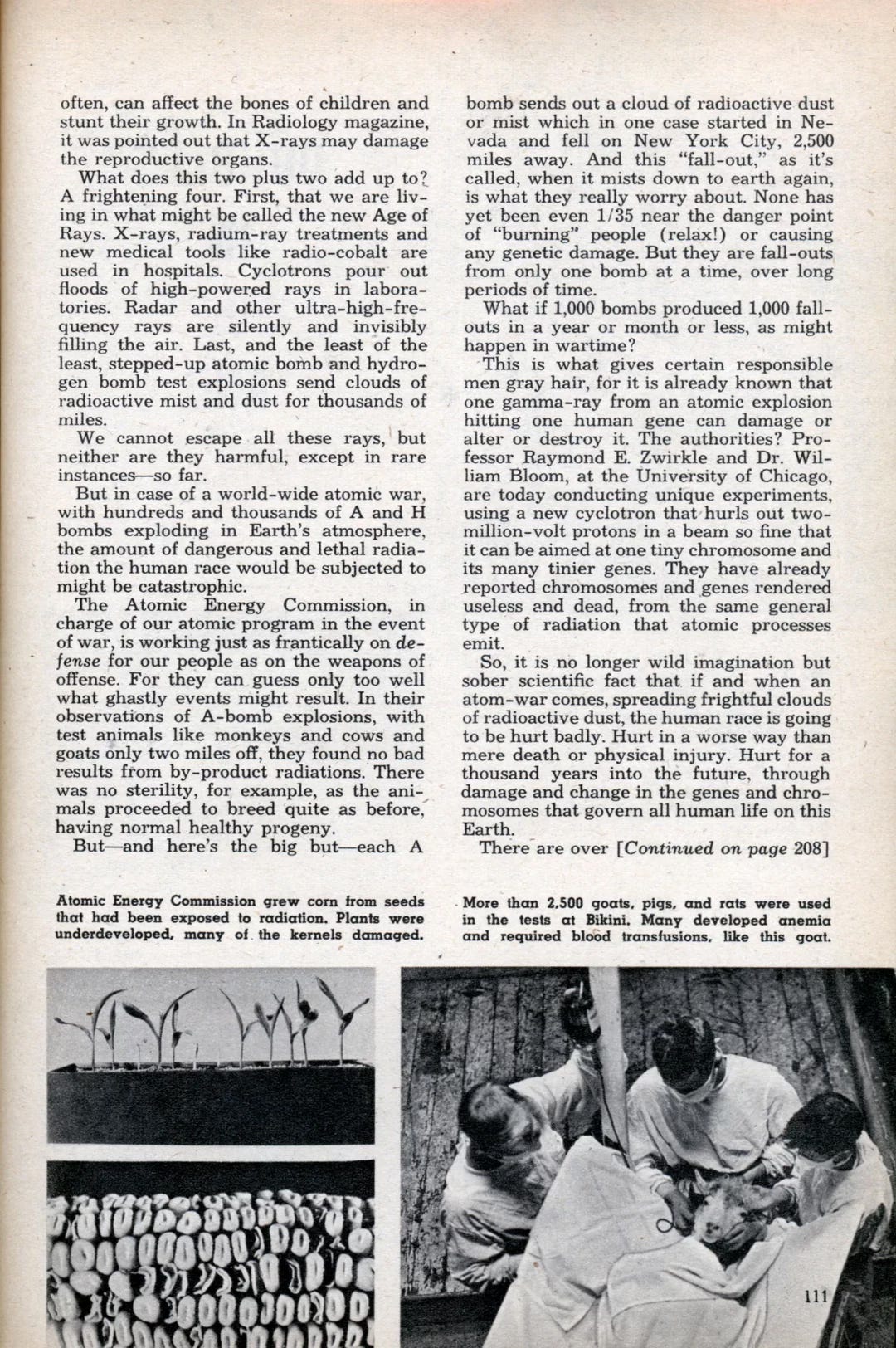
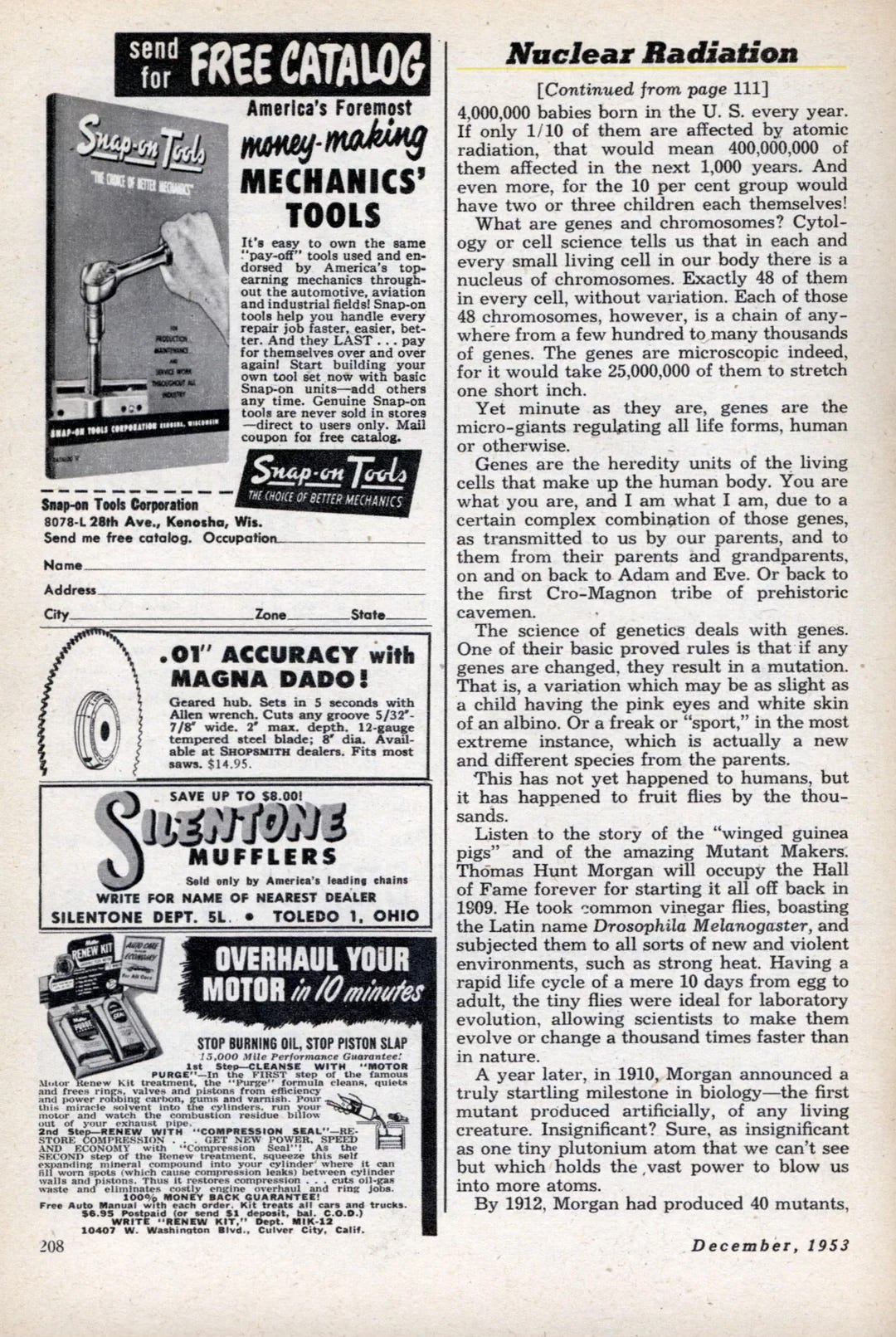
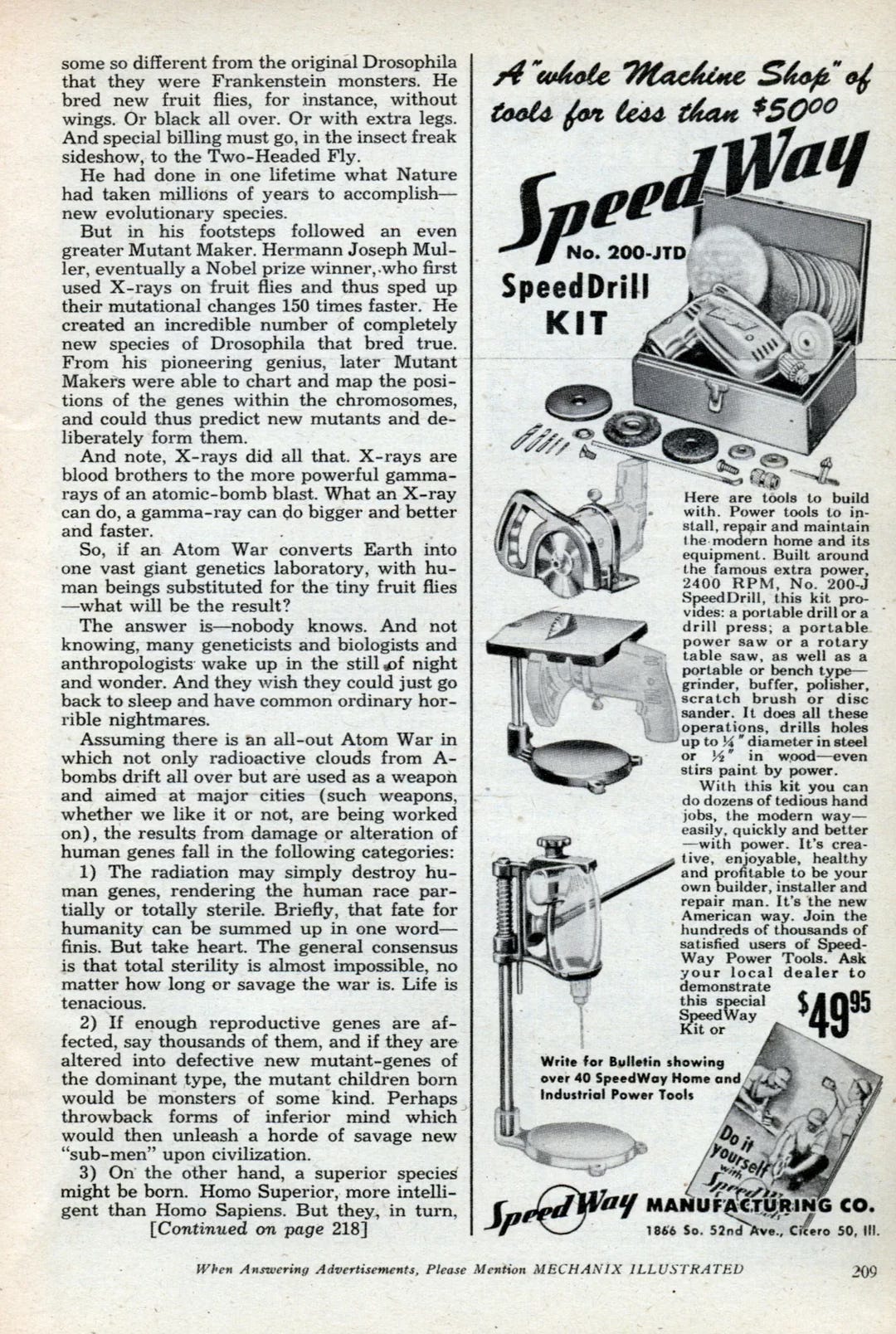
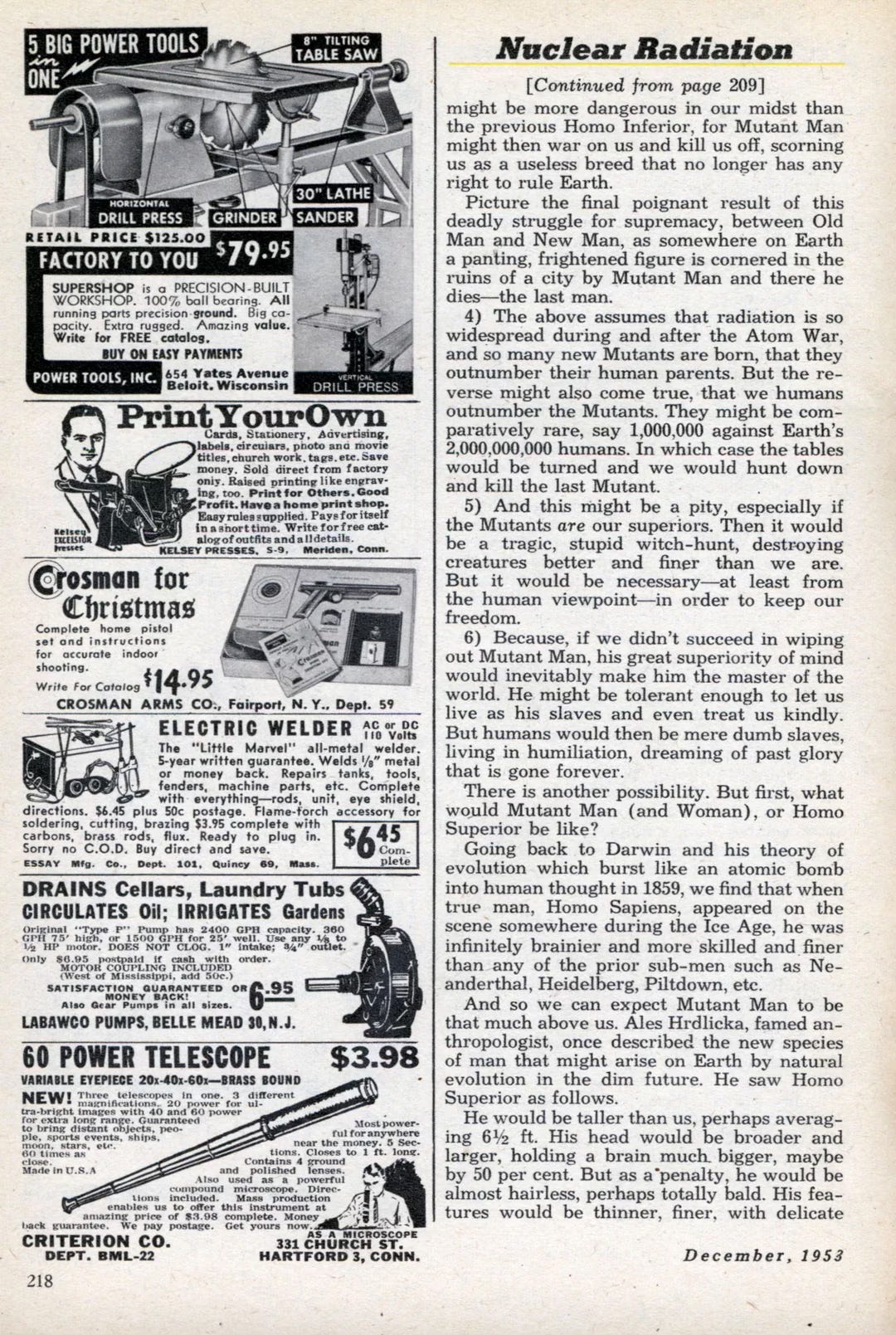
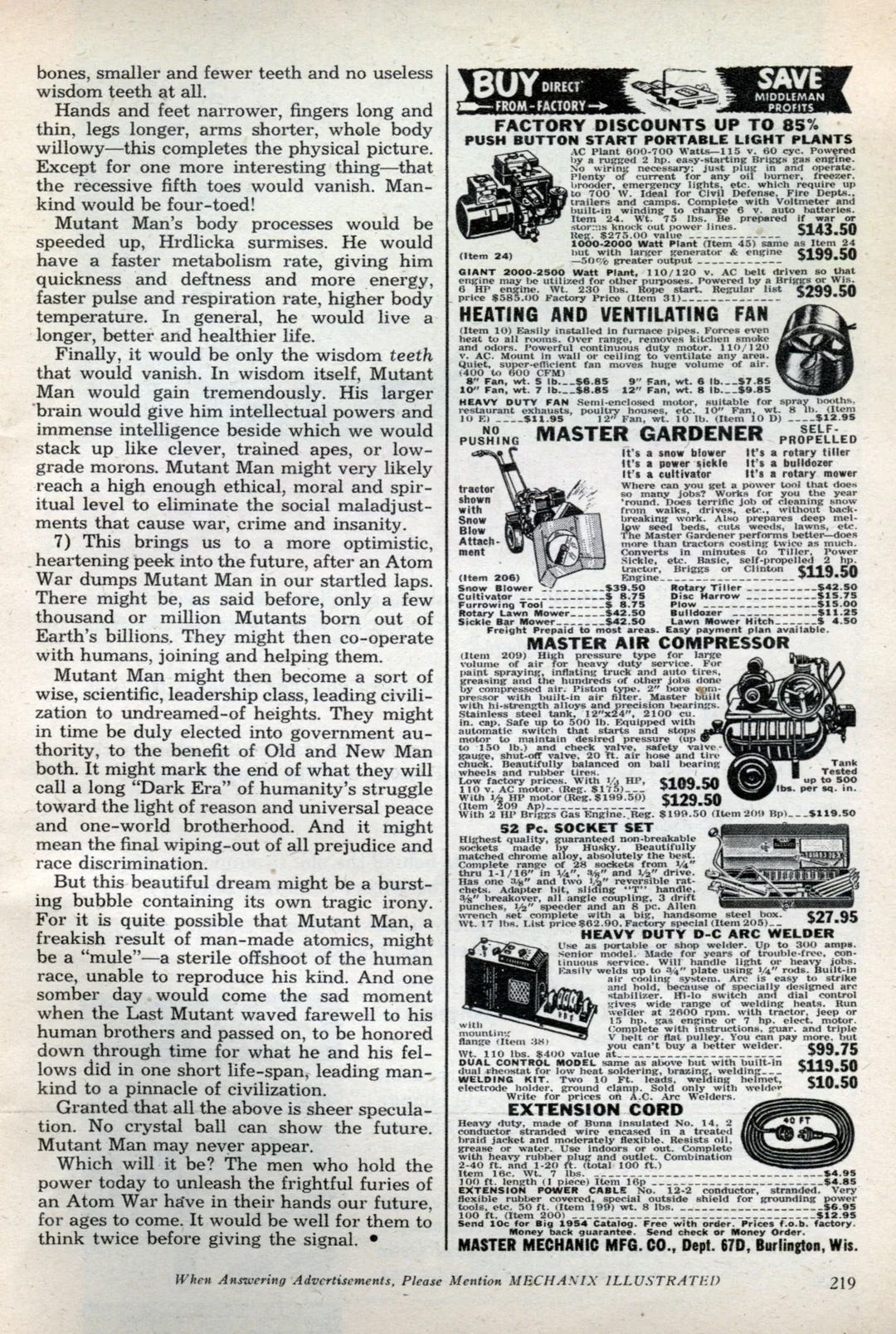
Thanks for the shout out! 😊
Sorry that I just now saw the notification, but I do appreciate it.
Thanks for the shout out! This post is fascinating!